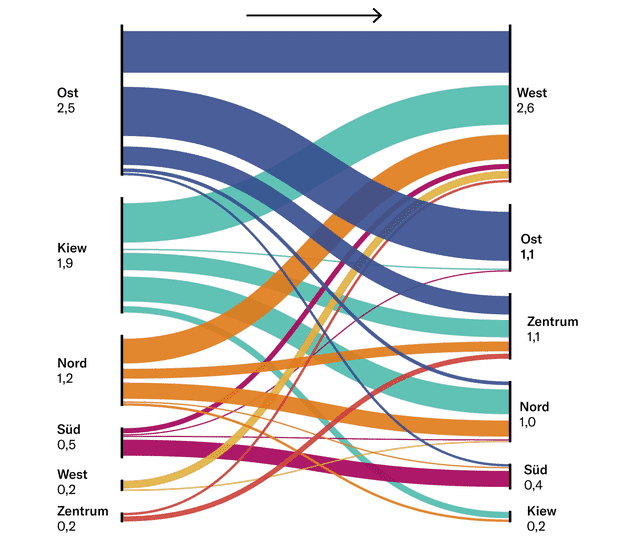The most important figures on the victims of the war – and how difficult it is to determine them.
Whether to a safe region of the country or to relatives in Western Europe – many people from Ukraine are fleeing.
Russia’s invasion of Ukraine means millions of Ukrainians have to leave their home country or city. Data from the UN refugee agency UNHCR show that Poland in particular has taken in many refugees. But other neighboring countries, including Russia, have so far registered more than 200,000 war refugees. More than 3.7 million people have already left the country.
The UNHCR usually collects these figures based on official numbers of border crossings, some values are estimates.
In addition, there are those refugees who have taken refuge in Ukraine. Around 6.5 million internally displaced persons The International Organization for Migration (IOM) as part of a representative survey in mid-March in Ukraine – that’s around 15 percent of the population. Many arrivals are recorded in the west of the country in particular, with the largest groups of refugees coming from the east of the country and from the capital region.
Many people were also displaced within their own greater region, in the east there are more than 1 million.
Around 20 percent of internally displaced persons state that they have “difficulties or great difficulties” in finding a roof over their heads. However, many stayed with relatives or friends. 55 percent of those surveyed state that they are no longer planning any further migration. However, 19 percent definitely wanted to move on.
Germany popular destination again
Some Ukrainians have made their way west from neighboring countries. Exactly where they are going is only gradually becoming clear. After the refugee crisis of 2015/16, Germany is once again a popular destination. The German federal police recorded a total of more than 250,000 people entering the country from Ukraine. For comparison: far fewer refugees were registered in France or Italy with 26,000 and 68,000 arrivals respectively.
Thousands of Ukrainians have also arrived in Switzerland in the past few days and weeks. There are already more than 14,000 registered refugees. Many of them have found accommodation with private individuals – for example with acquaintances or friends of the Ukrainian diaspora or with Swiss people who have agreed to take in people from Ukraine.
For a few days now, however, the State Secretariat for Migration (SEM) has no longer indicated where the registered refugees are staying. The SEM also does not regularly publish information on the age and gender of the refugees. The latest information is from March 9, when around 40 percent of the registered refugees were children and young people and around 70 percent were women and girls.
However, there are likely to be significantly more refugees from Ukraine in Switzerland than have officially registered so far. However, the SEM does not want to give an estimate of the number of unreported Ukrainian war refugees who have not (yet) been registered. “That would not be serious,” said spokesman Reto Kormann. Ukrainians can enter Switzerland without a visa and stay in Switzerland for up to 90 days without a permit.
The SEM registers the refugees in six federal asylum centers. According to Kormann, we know who is in a federal asylum center, a barracks or a hotel, who is in private accommodation or who has been taken into the care of a canton.
It is likely that many refugees stayed with relatives or acquaintances in Switzerland. According to the SEM, the Ukrainian diaspora in Switzerland comprises around 7,000 people, plus around 4,000 Swiss-Ukrainian dual citizens.
Difficult count of civilian casualties
There is also uncertainty about the number of people injured and killed in the Ukraine war. The United Nations High Commissioner for Human Rights (OHCHR) publishes new confirmed cases of deaths and injuries every day, but also adds that these figures probably greatly underestimate the actual number of victims.
The OHCHR has been recording civilian victims of the conflict in Ukraine since 2014. Interviews are conducted with those affected, relatives and eyewitnesses, and official information, publicly available information and other sources are consulted and compared.
However, the outbreak of war has made the recording more difficult. It is no longer possible to visit the sites of the events and to interview people directly there, according to the High Commissioner in its location updates. However, the remaining research methods, including the network of local contacts, are used to verify events.
Nevertheless, the numbers would probably increase afterwards, especially for the last few days recorded, because the verification of the events is currently taking a particularly long time.
Propaganda battle for the number of fallen soldiers
It is also difficult to record the number of military casualties on both sides. Both the Ukrainian and the Russian side have an interest in downplaying the number of victims on their own side. The only official Russian information (498 fallen soldiers, around 2,500 injured) comes from the beginning of March. On Wednesday (March 23) a NATO representative spoke out loud the AP news agency from 7,000 to 15,000 Russian soldiers killed.
On the Ukrainian side, President Zelensky spoke of 1,300 fallen soldiers on March 12. A few days earlier, a US government official walked away 2000 to 4000 fatalities on the Ukrainian side. This information is difficult to verify and covers a wide range – we therefore do not present it graphically in this article.
Even if many of the key figures in this crisis situation should be treated with caution and are likely to turn out to be wrong in retrospect, they still help to grasp the dimensions of this war and the resulting gigantic humanitarian challenge that Europe is likely to face in the near future.

